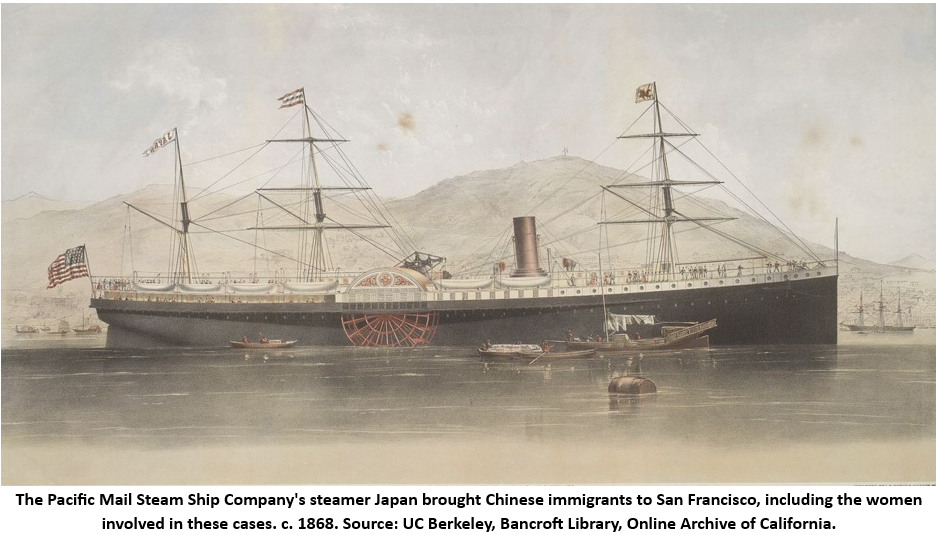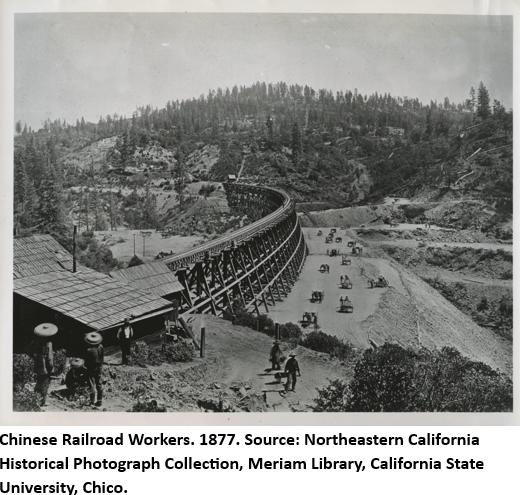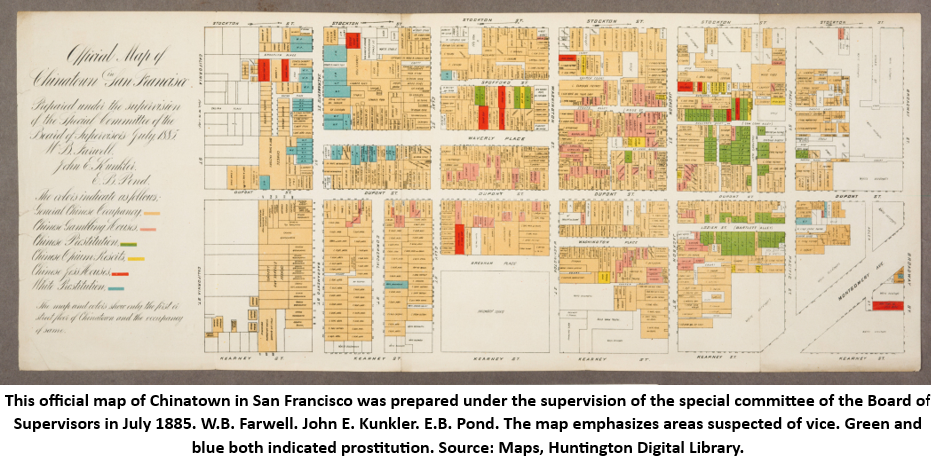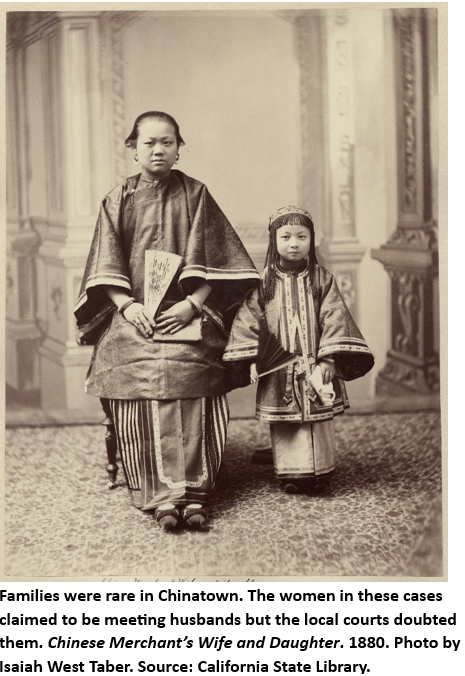You are here
Chy Lung v. Freeman: Anti-Chinese Sentiment and the Supremacy of Federal Immigration Law
On August 24, 1874, the steamship Japan arrived in the port of San Francisco. A local paper reported the steamer had been at sea for just over a month with “delightful” weather. The ship brought both goods, including more than 26,000 packages of tea, and passengers: locals returning home and hundreds of Chinese immigrants. Such reports were common at the time; immigration from China was on the rise, and Chinese tea imports were near their peak for this period. On August 24, 1874, the steamship Japan arrived in the port of San Francisco. A local paper reported the steamer had been at sea for just over a month with “delightful” weather. The ship brought both goods, including more than 26,000 packages of tea, and passengers: locals returning home and hundreds of Chinese immigrants. Such reports were common at the time; immigration from China was on the rise, and Chinese tea imports were near their peak for this period.

Events in the days following the Japan’s arrival reflected growing anti-Asian immigration sentiment in the late 19th century. Newspapers soon reported that more than twenty of the ship’s passengers were refused entry to the United States. Empowered by recent changes to California law, a state commissioner of immigration had identified those passengers as “lewd and debauched women” and instructed the ship’s master to provide a bond for them to disembark. The shipmaster refused, resulting in their detainment on the ship. Multiple petitions for a writ of habeas corpus followed in both state and federal courts culminating in a Supreme Court decision. The women’s detention which raised questions about federalism, foreign policy, and immigration, excited public comment tied to societal tensions about Chinese immigration and gender. Ultimately, Chy Lung v. Freeman helped establish the supremacy of federal over state regulation of immigration.
The events that culminated in Chy Lung v. Freeman had their roots in the increased Chinese immigration that began in the mid-nineteenth century with the Gold Rush. Migrants first came to work in the mines, with later arrivals moving into other industries, most significantly the building of western railroads. As the number of immigrants increased, so too did animosity towards the newcomers. Gold mining was fiercely competitive, leading to economic tensions between different groups of prospectors. But cultural differences, racism, and xenophobia were the real drivers of widespread anti-Chinese sentiment. Chinese immigrants often lived in ethnic enclaves that outsiders viewed as disease and vice ridden; “Chinatowns” arose partially due to discriminatory housing practices. They, nonetheless, contributed to suspicion and hostility among white Americans. This animus evolved into efforts to construct legal barriers to Chinese immigration.

In this milieu, California passed a series of laws aimed at curtailing Chinese immigration. Some laws directly prohibited immigration; others restricted the kind of work open to Chinese immigrants, or required them to obtain special licenses or pay special taxes. Several of the state’s laws were eventually ruled to violate either the California or the U.S. Constitution. Most of these laws targeted the single, male laborers who made up the majority of Chinese immigrants. Some, however, specifically targeted women by taking aim at prostitutes, which many women in Chinatown were presumed to be. The portion of the law at stake in Chy Lung v. Freeman was just such a restriction.
In 1870, California passed an immigration statute requiring East Asian women, among other things, to provide satisfactory proof that they were of good character and traveling of their own free will. In 1874, the Act was amended to apply to anyone entering California by sea while placing the onus of compliance on the shipmaster. He had to satisfy the commissioner of immigration that no passenger was part of a number of listed classes, one of which was “lewd or debauched” women. If the commissioner was not satisfied, the shipmaster either had to return the passenger(s) to their country of origin or post a bond of $500 to the state. When the Japan’s master refused to post bond for the women the state commissioner identified as lewd or debauched and multiple people challenged the women’s subsequent detention, the law came before the courts.
The first effort to free the women came on August 25, the day after their arrival. A local Chinese man[1] petitioned the Supreme Court of California for a writ of habeas corpus, leading to a closely watched hearing in front of Judge Morrison in the Fourth Judicial District Court in San Francisco. The case drew significant legal and public interest. Lawyers appeared for the petitioners, the steamship company, the commissioner, and the people. The petitioner’s representative, Leander Quint, was a prominent local attorney, a former judge, district attorney, and state senator. Arguments at the hearing focused on two distinct questions: Was the law constitutional? And if so, were these women in fact part of the excluded class, that is, were they “lewd and debauched”?

In his decision, Judge Morrison noted that he initially concluded the law was constitutional after only preliminary arguments but was “induced” to give the question a “more thorough investigation” by the attorneys’ forceful arguments. Those arguments claimed that the state of California had overstepped Congressional power as granted by the Constitution. The commissioner did not have the authority to assess the women’s moral character, since Congress had given that sort of power to U.S. consuls. The petitioners’ counsel further argued the law conflicted with the Burlingame Treaty, which among other provisions promised the Chinese free immigration to the United States.
The additional examination of these arguments did not change Morrison’s mind, however. In his decision, he wrote that he had “no doubt that under the constitution of the United States, it is competent for the legislature of the state to pass such a law as the law now in question.” He disposed of the petitioners’ arguments quickly, stating that it was well established states could restrict the immigration of those likely to become a public charge and that the law restricted a class of people, not the Chinese.
At the initial hearing, the second question occupied much of the court’s time and drew the most interest from the press, undoubtedly because of anti-Chinese fervor and the stereotypes surrounding Chinese immigrants. The court heard repeatedly that the majority of women coming to the United States were prostitutes or “bad women,” as the judge put it in one question to a witness. This view was backed up and applied to the women in this case by testimony from both white law enforcement and Chinese men. The women themselves testified they were meeting their husbands in California but were unable to prove this to either the judge’s or most observers’ satisfaction. Most notable to Judge Morrison was the fact the husbands “did not appear” in court.[2]
News reports about the trial emphasized the perceived cultural otherness of the women. The court heard a significant amount of contradictory testimony about whether the fashion of married women and prostitutes differed markedly. The women’s behavior was also dissected. The San Francisco Chronicle described the women erupting in an “infernal chorus” of grief at one point. An interpreter explained that the women were saying they could not understand why they were being kept in prison, but the paper reported onlookers questioned their sincerity. After all the testimony, Judge Morrison still found the women’s status difficult to pin down. Evidence that they were “lewd” women was only circumstantial, he observed, but the burden was still on the women to prove otherwise. After discussing the testimony at length, he said that he believed they were prostitutes.

With Morrison’s decision, the women were escorted back to the wharf to be returned to the steamship—but only for the briefest moment. The same day, a new petition for a writ of habeas corpus was filed in the California Supreme Court, leading the women to be moved to the coroner’s custody ahead of a second hearing, this time in the state’s Supreme Court. In Ex parte Ah Fook, the higher court was also unconvinced that the California statute violated the Constitution or contradicted the Burlingame Treaty. On the constitutional point, the decision stated that states’ ability to prohibit the immigration of “criminals or paupers” was well established. The court saw little difference in the restriction at issue.
The San Francisco papers greeted the decision with much enthusiasm. The Examiner expressed a hope that when the women reached home, they would remain there and “advise their lady friends to do likewise, which will be to the advantage of the Americans here resident.”
This was not the end of the legal battle, however.
Before the Supreme Court reviewed the case, the women’s detainment came into the federal courts via a different writ of habeas corpus petition—this one in the U.S. Circuit Court for the District of California. Judges Lorenzo Sawyer and Ogden Hoffman and Justice Stephen Field, riding circuit, heard arguments for several days during the third week of September. In his decision, Justice Field explained the federal courts’ jurisdiction and this case’s relationship to the state cases. First, he traced the women’s recent experiences being repeatedly shifted between the custody of the shipping company, the coroner, and the sheriff as their fate was decided by state courts. He then explained that the petitioner, one of the women, had a right to petition in federal courts because she was the subject of another country that had treaty relations with the United States. He further noted that the circuit court was hearing the case anew and did not need to consider the decisions of the state courts. Justice Field went on to address the legal questions.

The circuit court case focused less on the women’s character and more on the California statute, which Field criticized at length. Essentially, he found the statute to be lacking in necessary specificity. He said it was “not entitled to any very high commendation” due to its “sweeping” terms. The statute, for example, potentially limited entry of “the deaf, the dumb, the blind, the crippled and the infirm” without regard to wealth or the ability to support themselves. He further pointed out that the statute did not distinguish between past and present status and behavior with regards to paupers and “lewd and debauched women.” Nor did it distinguish “between the woman debauched by intemperance in food or drink, or debauched by the loss of her chastity.”
While the statute in question was exceedingly broad and general, the power of the state to exclude foreigners was limited to self-defense, according to the court. Anything beyond a narrowly defined self-defense was the province of the federal government. If, as presumably was the case here, the problem was that a foreigner was expected to break the law, the remedy was in “vigorous enforcement of the laws,” not in exclusion. The court ruled that the detention of the women was unlawful due to the Burlingame Treaty and a federal statute. The treaty, which was an asset to Chinese immigrants fighting state restrictions in several cases, forbade any limitation on the entry of Chinese subjects that was not applied to the most favored nation. The federal government had not applied this limitation to all immigrants; thus, it violated the treaty. Additionally, the state statute violated an act of Congress that restricted the ability of a state to place a “tax or charge” on a person immigrating. Both the Fourteenth Amendment and the federal statute required any charge to be applied equally to everyone immigrating, yet the state statute only applied to those arriving on vessels in a port. With this reasoning, the court ordered that the petitioner be released.

The circuit court’s decision ended most of the women’s ordeal, but one woman took the state case to the Supreme Court. The Court speculated on the petitioner’s reasoning in its decision: “All of plaintiff’s companions were released from custody of the sheriff on a writ of habeas corpus issued by Mr. Justice Field of this court. But plaintiff by writ of error brings the judgment of the Supreme Court of California to this court, for the purpose, as we suppose, of testing the constitutionality of the act under which she is held prisoner.” The state of California neither provided a brief nor made arguments defending the statute to the Court. The Supreme Court agreed with the circuit court and found the statute unconstitutional.
Just as Justice Field had done, Justice Miller, writing for the Court, began by lambasting the state law. He focused on the immense power given to the commissioner, his financial incentives (the commissioner could charge the shipmaster for each portion of his work related to the law), and a commissioner’s ability to enforce the law in a discriminatory manner. “It is hardly possible to conceive a statute more skillfully framed, to place in the hands of a single man the power to prevent entirely vessels engaged in a foreign trade, say with China, from carrying passengers, or to compel them to submit to systematic extortion of the grossest kind.”
From there, the decision was both shorter and simpler than the circuit court’s. The power to regulate immigration belonged to Congress, in part because immigration restrictions had the potential to create international tensions. Per the Constitution, the federal government had both the power to regulate commerce with foreign nations and the responsibility to contend with any resulting conflicts. Unlike the circuit court and California’s supreme court, the Court did not concede a clear power for the state to limit, in the absence of a contrary federal statute, entry of paupers, criminals, or any other group for self-protection. Instead, the Court said it was not necessary for it to decide if or how much a state could do so, because this law was obviously not acceptable. The law in question was “so far beyond what is necessary, or even appropriate, for this purpose, as to be wholly without any sound definition of the right under which it is supposed to be justified.” The law was unconstitutional, and the California Supreme Court’s judgment was reversed. The Court’s decision directed the final prisoner to be released from custody.

Despite the Supreme Court’s ruling, the climate surrounding Chinese immigration was moving more towards the California statute’s intent than away from it. By the time the Court issued its decision, Congress had passed the Page Act of 1875, which was one of the first pieces of federal legislation to specifically target Asian immigrants. Though it included other provisions, the Page Act’s most prominent and enforceable restriction was on Asian women. It forbade the “importation … of women for the purposes of prostitution.” Like the California law before it, the Page Act empowered immigration officials, federal ones here, to determine if Asian women were being trafficked “for lewd and immoral purposes.” If they were so identified, officials could bar them from entry. Within the context of still growing anti-Chinese sentiment and the ongoing perception that most Chinese women were prostitutes, the law, then, effectively allowed immigration officials to keep almost any Chinese woman from entering the United States if they desired. This Act also violated the Burlingame Treaty, but Congress passed it, nonetheless. Then, more famously, in 1882, Congress passed the Chinese Exclusion Act, restricting the immigration of all Chinese laborers.
The story of the Japan detainees reflects the animosity toward the Chinese brewing in the United States during the late nineteenth century. That feeling was strongest on the West Coast, where most Chinese immigrants settled, leading California to be on the front edge of legislative attempts to restrict their immigration. While the Supreme Court ruling in Chy Lung v. Freeman was largely overtaken by later events, it was nonetheless an important decision. It made clear that the federal government, not the states, held the power to regulate immigration and foreign relations and has been cited in subsequent cases about related questions.
[1] One alleged husband did come to the court, but he was put in a lineup, of sorts, with five other men, and none of the women could pick him out. This created even more suspicion in the eyes of the court.
[2] The exact identity and relationship of this person to the women is unclear. Reports varied, with some news sources reporting multiple men were involved in the petition. Many reports took for granted that at least some of the women were prostitutes and reported that the man had a business relationship with them.
Christine Lamberson, Director, Federal Judicial History Office
For more information, contact history@fjc.gov
Related FJC Resources:
Read about another case involving a Chinese immigrant in Lucy Salyer. Chew Heong v. U.S.: Chinese Exclusion and the Federal Courts. Washington: Federal Judicial Center, 2006.
Read the biographies of Justices Stephen Field and Samuel Miller and Judges Lorenzo Sawyer and Ogden Hoffman.
Case Decisions:
Chy Lung v. Freeman, 92 U.S. 275 (1876).
Ex Parte Ah Fook, 49 Cal. 402 (1874).
In re Ah Fong, 1 F. Cas. 213 (Cir. Ct. D. Cal. 1874).
In re Chy Lung (Dist. Ct., 4th Jud. Dist. San Francisco, Cal. Aug. 29, 1874). Published in A Righteous Decision: Judge Morrison Orders the Chinese Courtesans to Be Taken Back to China, S.F. Chronicle, at 5 (Aug. 30, 1874).
Further Reading:
Justice For All: Courts and the Community. “Reenactments—Historic Courtroom Theater | 22 Lewd Chinese Women.” Accessed November 14, 2023.
Salyer, Lucy E. Laws Harsh As Tigers: Chinese Immigrants and the Shaping of Modern Immigration Law. 2d ed. Chapel Hill, N.C.: The University of North Carolina Press, 1995.
This Federal Judicial Center publication was undertaken in furtherance of the Center’s statutory mission to “conduct, coordinate, and encourage programs relating to the history of the judicial branch of the United States government.” While the Center regards the content as responsible and valuable, these materials do not reflect policy or recommendations of the Board of the Federal Judicial Center.
